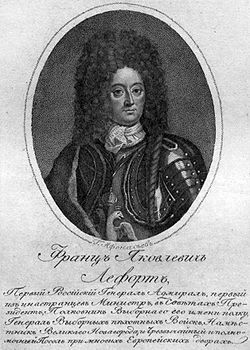프랑수아 르포르 (제독)
François Le Fort (admiral)François Jacques Le Fort also spelled Lefort (Russian: Франц Яковлевич Лефорт, tr.프란츠 야코블레비치 레포르트(1656년 1월 2일~1699년 3월 2일)는 제네반 태생의 러시아 군인, 장군(1695년)이자 차르 피터 대제의 가까운 동료였다.
제네바에서 태어난 프랑수아 르포르는 상인 집안 출신이다.그는 네덜란드 군대에서 군 생활을 시작했다.1675년 르포트는 러시아 군대에서 일자리를 찾기 위해 프러시아 대령 야콥 반 프로스텐과[1] 함께 아크엔젤스크에 도착했다.1676년 2월 그는 모스크바에 왔지만 군 관계자들은 그를 거절했다.포솔스키 프리카즈는 그를 방문 외국인으로 등록했다.르포트는 모스크바의 소위 네메츠카야 슬로보다에 정착했는데, 그곳에서 그는 다른 저명한 외국인들 사이에서 존경을 받았다.1678년 7월 그는 다시 한번 차르제 군대에 지원했다.대위의 계급으로 받아들여진 르포르는 1676-1681년 러시아-터키 전쟁 동안 전선으로 이동했다.1679년 초, 그는 바실리 골리친 왕자와 패트릭 고든 장군이 지휘하는 키예프 수비대에 합류하라는 명령을 받았다.1683년 제네바에서 짧은 여행을 마치고 모스크바로 돌아온 르포르는 1685년 가을까지 다양한 외교 임무를 수행했다.
르포르의 집은 점차 네메츠카야 슬로보단(Nemetskaya sloboda)의 주요 명소로 바뀌어, 지역 주민들뿐만 아니라 골리친(Golitsyns)과 같은 러시아 귀족들이 참석했다.르포르가 후자와의 연줄을 이용해 빠른 [citation needed]승진을 한 것으로 보인다.
1687년과 1689년에 그는 두 번의 크림 원정에 참여했다.피터 대제는 1690년부터 르포르의 집에 단골손님이 되었다.르포르는 피터의 군사 게임의 주요 주최자 중 한 명이었고, 이것은 그의 경력 승진의 길을 열어줄 것이다.1690년 르포르는 소장으로 진급했다.그 후 그는 중장과 장군이 되었다.1692년 피터 1세는 르포르의 집을 확장한 1,500명을 위한 큰 리셉션 홀을 건설하는 데 자금을 지원했다.이 홀은 관리 회의와 피터의 파티를 열었다.르포르의 파티는 곧 악명이 높아졌고, 러시아의 피터 1세와 같은 고귀한 손님들이 평소에도 참석했습니다.그들은 함께 러시아 정교회뿐만 아니라 로마 가톨릭 교회로부터도 그들의 절차를 [2]일상적으로 조롱하는 것으로 주목할 만한 비판을 받은 최초의 모의 종교들 중 하나인 만우회, 만우회, 예수회를 결성할 것이다.
In 1691 Le Fort was put in charge of a regiment and assigned a training ground on the left bank of the Yauza River. Peter ordered the construction of a sloboda for this purpose, which would later be called Lefortovskaya sloboda (the Lefort quarter, present-day Lefortovo in Moscow's South-Eastern Administrative Okrug). In 1693–1694 Lefort accompanied Peter on his trip to Arkhangelsk. In 1694 he participated in Peter's "play" Kozhukhov campaign (a military game in the village of Kozhukhovo, between Moscow and Kolomenskoye).
During the Azov campaigns of 1695–1696 Le Fort was in charge of the Imperial Russian Navy. His return from the war was marked with a solemn parade through Moscow to his "native" Nemetskaya sloboda and subsequent festivities. Lefort was awarded a title of governor (наместник, or namestnik) of Novgorod and estates in two uyezds.
In 1696 Le Fort together with Fedor Golovin and Prokopy Voznitsyn took official charge of Peter's Grand Embassy, a Russian diplomatic mission to Western Europe. Upon his return to Moscow in 1698 he took part in the trial of the Streltsy rebels. That same year he moved to a custom-built palace, later known as the Lefortovsky Palace, on the Yauza River. The palace would soon become a center of Russian political and royal life in 1698–1699. Peter the Great used to hold all his important meetings and numerous celebrations in Le Fort's palace.
François Le Fort died in Moscow in early March 1699. Upon hearing the news of his death, Tsar Peter lamented "Now I am alone without one trusty man. He alone was faithful to me. Whom can I confide in now?" On March 21 Peter held Lefort's state funeral, a ceremony second only to the funerals of Tsars or Patriarchs.[3] Le Fort lies buried in the Vvedenskoye Cemetery in Lefortovo.
The Russian 84-gun ship-of-the-line Lefort (launched 1835, shipwrecked 1857) was named in honor of Lefort.
References
- ^ Posselt, Moritz (1866). Der General und Admiral Franz Lefort: Sein Leben und seine Zeit. Ein Beitrag zur Geschichte Peter's des Grossen [General and Admiral Franz Lefort: his life and times. A contribution to the history of Peter the Great] (in German). Vol. 1. Frankfurt am Main: Joseph Baer. p. 194. Retrieved 2017-01-24.
Oberst Jacob van Frosten, ein Preusse, in der Stadt Danzig geboren; er hat anfangs in Schweden, dann in Spanien und endlich in Holland als Oberst gedient.
- ^ Massie, Robert K. (October 1981). Peter the Great: His Life and World. New York City: Ballantine Books. p. 278. ISBN 0-345-29806-3.
- ^ Massie, Robert K. (October 1981). Peter the Great: His Life and World. New York City: Ballantine Books. p. 278. ISBN 0-345-29806-3.




